Kanji Meaning “See”: 見 (Mi)
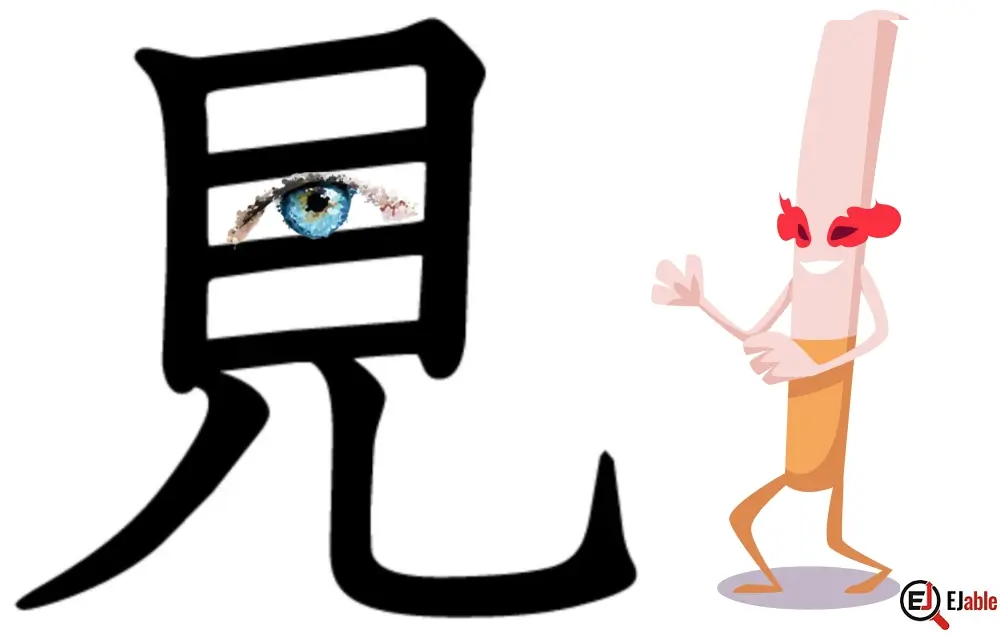
The Japanese kanji meaning “to see” or “look at” is 見.
The kun’yomi (Japanese reading) pronunciation of the Kanji 見 is “mi” (み), as in words “mi-ru” (み-る) meaning “see,” “mi-seru” (み-せる) meaning “can see,” and “mi-eru” (み-える) meaning “to show.” The on’yomi (Chinese reading) pronunciation of 見 is “ken” (ケン).
The Kanji 見 is constructed with 7 strokes. 見 is part of the JLPT N5 syllabus (please check the list of JLPT N5 Kanji). In Japanese schools, this Kanji is taught in grade 1.
Origin of the Shape 見
If we see the old shape of the Kanji 見 in the Oracle Bone Script, it depicts a person with an “eye.” Later, this shape changed to the Kanji component of “eye” with the radical for “legs.” However, the original shape and the evolved shape of 見 represent “movement” with “eyes” to mean that one needs to move with eyes to see things.
Let’s see the evolution of the shape of the Kanji 見, meaning “to see” or “to look at,” from ancient times to the current:
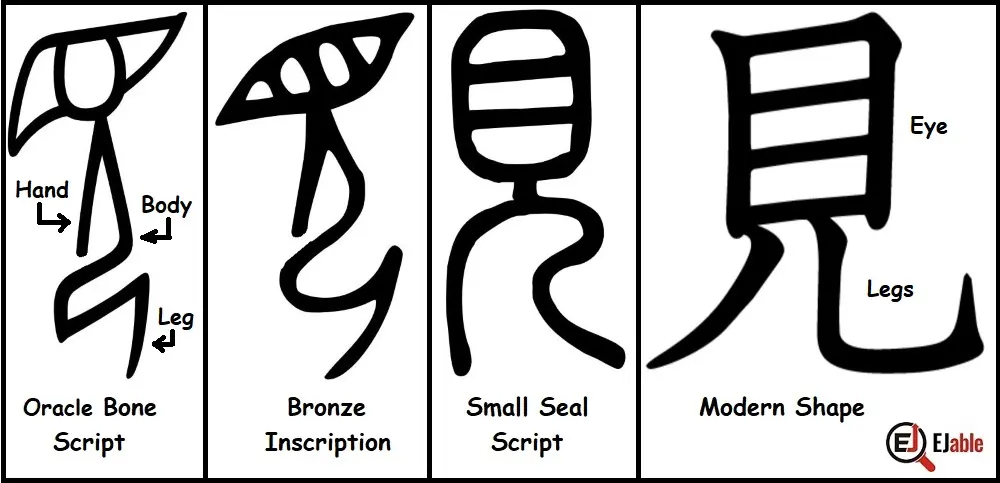
The above image shows the historical shape of 見 in Oracle Bone Script, Bronze inscription, small seal script, and how we write it in the present.
Mnemonic: How to Remember the Kanji 見 for Seeing
It is quite easy to remember the Kanji 見 with the following two points:
- Knowing the Kanji for eye
- Remembering the logic of combining eye with movement, i.e., legs
Considering the above, the following illustration can serve as a mnemonic to remember this Kanji:
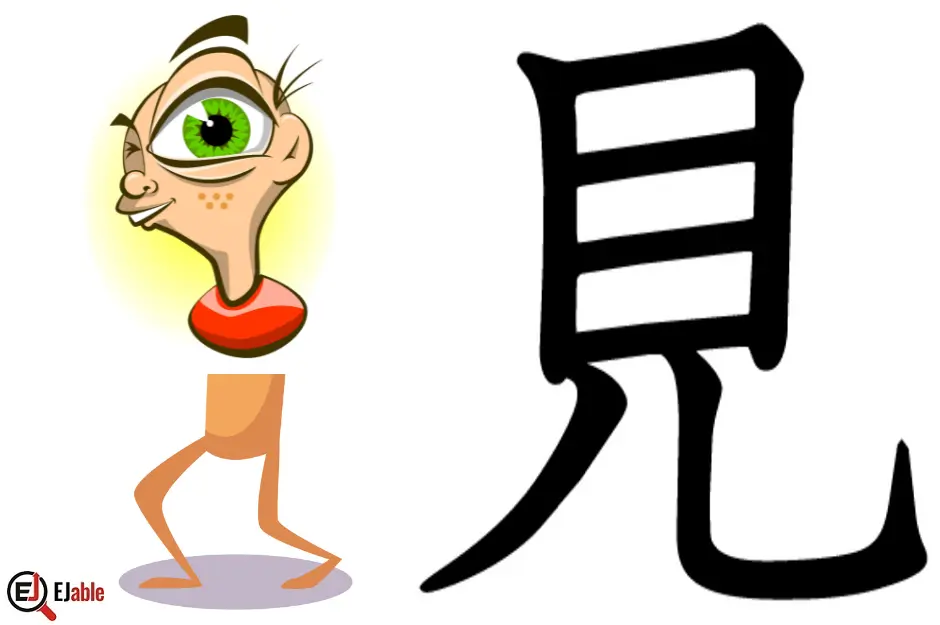
Stroke Order for the Kanji 見
The following illustrations show the order of the 7 strokes to write the Kanji 見:
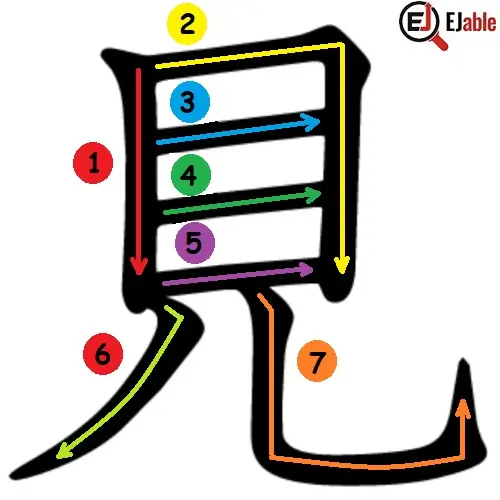
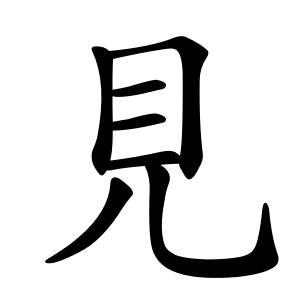
Kanji for Seeing 見 as a Radical or Component
The Kanji 見 is used as a radical or component in 75 Kanji characters, out of which 8 are Jōyō (commonly used) Kanji.
In these other Kanji, 見 contributes meanings related to sight, observation, or perception.
Examples of Kanji 見 as Radical or Component
Here are the Jōyō Kanji characters that include the 見 radical or component:
- 親 (おや / oya, しん / shin): Parent, close; suggests looking after or being close enough to observe well.
- 現: ゲン / gen (present), あらわ-れる / Arawareru (present / to appear), あらわす / Arawasu (to show, express)
- 覚 (かく / kaku): To remember, to awaken; entails the aspect of seeing to recall or become aware.
- 観 (カン): outlook
- 規 (き / ki): Standard, rule; involves the concept of looking to establish norms.
- 視 (し / shi): Vision, to look at.
- 寛 (カン / kan): leniency, generosity
- 覧 (らん / ran): To view, to inspect; focuses on the act of seeing in detail.
Kanji 見 in Compounded Words
The kanji 見 appears commonly in Japanese and forms part of many compound words. There are 265 Japanese words that begin with the Kanji 行, and it appears in 1532 words.
Examples of Kanji 見 in Compounded Kanji Characters
- 見学 (けんがく / kengaku): Field trip; visiting a place to see and learn about it.
- 見積もり (みつもり / mitsumori): Estimate; calculating cost or size by examining.
- 発見 (はっけん / hakken): Discovery; finding something by looking carefully.
- 見事 (みごと / migoto): Splendid; something that looks wonderful or is admirable upon seeing
- 見本 (みほん / mihon): Sample; a model or specimen for examination.
- 予見 (よけん / yoken): Foresee; predicting something by looking ahead.
- 見込み (みこみ / mikomi): Prospect; expectation based on what one sees or assesses.
- 見解 (けんかい / kenkai): Opinion; a viewpoint formed by observing or considering something.
- 見返り (みかえり / mikaeri): Return; benefits received in exchange for something, or literally looking back.
- 見送り (みおくり / miokuri): Seeing off; watching someone leave or saying goodbye.
These compound words demonstrate the use of 見 in expressing various concepts related to visual perception, understanding, and assessment. Overall, all these meanings are related to seeing or looking at things.
Note: Check other Kanji characters on the page “How to Remember Kanji“.

A long-term ex-pat in Japan, Himanshu comes with an IT background in SAP consulting, IT Business Development, and then running the country operations of an IT consulting multinational. Himanshu is the co-founder and Managing Director of ReachExt K.K. and EJable.com. He is also an Advisory Board Member of a Silicon Valley AI/IoT startup.
